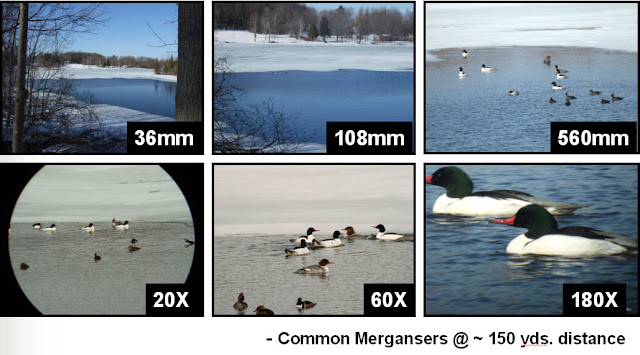Digiscoping: Magnification? (Updated 2017)

What kind of magnifications can I get?

Digiscopers like Mike McDowell have come up w/ a formula for calculating the approximate magnifications capable with a given digiscoping setup:
EFL*=(FLc/35mm)*EPmag*50mm
where
EFL = Effective focal length of digiscoping rig
FLc = focal length range of P&S camera (mm)
Epmag = Scope eyepiece magnification
50mm = equivalent 35mm camera magnification (1X)
So, for example: a Nikon Coolpix P6000 w/ 24-112mm lens range at 112mm (4x) on a Zeiss 20-60x eyepiece at 20x would give EFL = (112/35)*20*50 = 3200 mm! The total range of magnification for this rig is ~800 - 9600mm! or 20 - 240X!
With mirrorless cameras becoming more popular with today's digiscoping rigs, one can get a magnification using this simple formula:
EFL* = EpMag * CFcamera * FLc
where CFcamera = crop factor of camera.
So, for a Nikon V1 w/ 10-30mm lens at 30 mm on a Zeiss 85T*Fl and 20-75X Vario Zoom eyepiece at 75X one can get an effective focal length of 75*2.7*30 = 6075 mm!
--- Updated 2017 ---
My latest rig is a Swarovski STX85 Scope w/ a 20-60X Zoom Eyepiece. Digiscoping with a Sony a6300 Camera and a Sigma 30mm f/2.8 my effective magnification range is 20to60*30*1.5 = 900mm to 2700mm. My overall magnification range may be reduced, but the larger sensor and increased pixel range (24MPx) produces stunning images that can be cropped for higher magnification.
But do yourself a favor and work at the lowest magnifications on the camera (14-18 mm) and scope (20-30X) for sharpest images and most keepers. Increasing magnification increases vibration and motion blur.
More importantly, as you increase scope magnification the required distance between eyepiece and camera lens decreases to a point where its impossible to maintain optimal focal plane sharpness. The result is a blurred image no matter how stable your rig may be.
A rule of thumb: It is better to crop for magnification than to zoom for magnification.



Comments